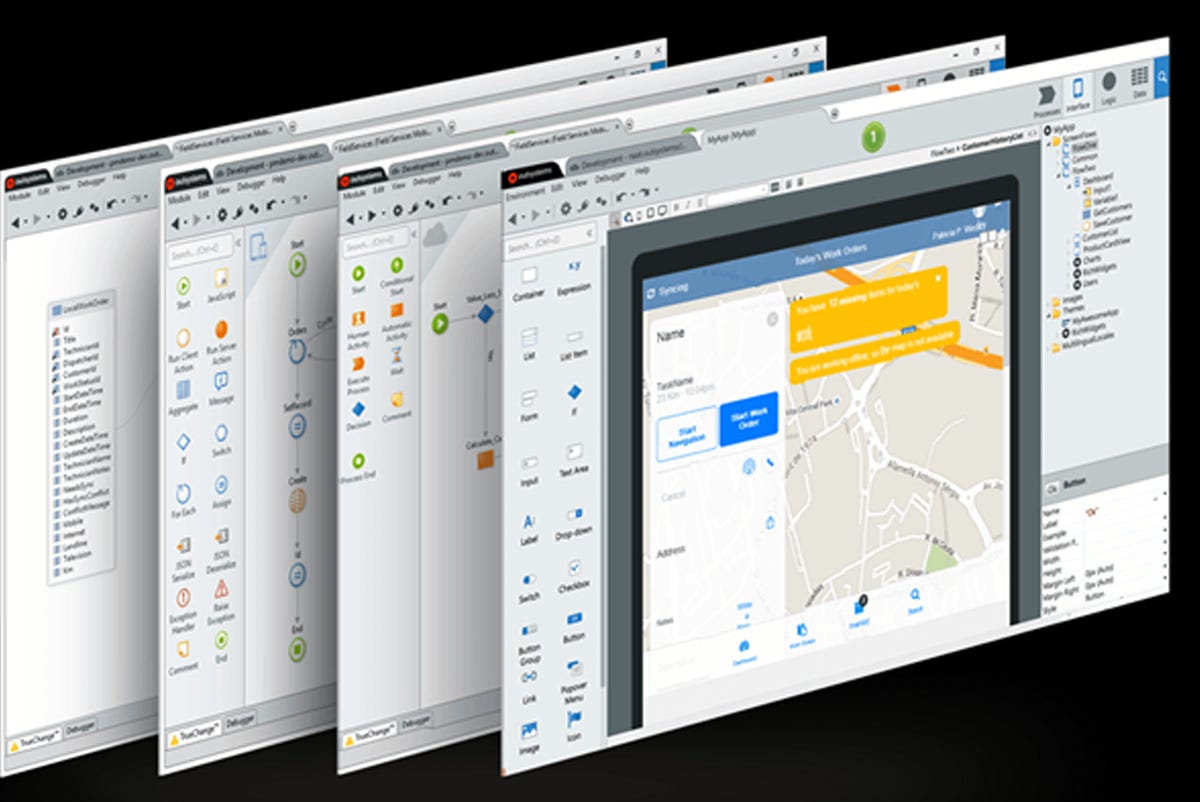Is IT possible without IT?
In recent times, there has been a flurry of activity around platform offerings targeted at users with little or development experience — so-called “citizen developers” — as well as still serving the needs of professional developers hard-pressed to deliver apps in extremely tight timeframes. This new generation of low-code and no-code platforms are designed to make it relatively easy for people to design, build, and launch applications quickly, without having to worry about the nuances of underlying operating systems or scalability requirements.
Also: ‘Weird new things are happening in software,’ says Stanford AI professor Chris Re
Built on extended cloud-based Platform-as-a-service environments and low- and no-code platforms typically employ visual programming interfaces to solve business problems faster and more completely than could be accomplished with traditional software development. In the process, the productivity of professional developers will be enhanced as they are freed up to worry about more strategic infrastructure concerns affecting their enterprises.
The widespread dispersal of organizations that took place over the past year accelerated the low- and no-code movement, a survey by KPMG finds. Since the onset of the COVID-19 crisis, the number of executives naming low- and no-code development platforms as their most important automation investment has nearly tripled, from 10% to 26%. In addition, KPMG finds, 100% of enterprises who have implemented a low- and no-code development platform have seen ROI through these initiatives.
Within the next two years, Gartner predicts, more than half of medium to large enterprises will have adopted low-code application platforms. A survey of 324 organizations by Unisphere Research/Information Today, Inc., found at least 76% already had at least some portion of applications developed outside of traditional IT departments or service providers. They turn around their required applications in a matter of weeks, and only 17% report turnaround times exceeding three months. Non-IT developers come from a range of backgrounds, the survey found, but are, for the most part, power users and developers embedded within line-of-business departments building the applications. Challenges to low- and no-code development include data security and trouble learning proper programming techniques, and handling of data, the survey also showed.
Low- and no-code often get used interchangeably, but there’s a shade of difference between the two categories. Low-code solutions, typically target users with some development experience, or developers needing to quickly build apps, employing visual development environments and automated linkages to back-end systems, databases, web services, or APIs. No-code solutions take this abstraction a step further, introducing visual drag-and-drop interfaces that involve no coding at all.
Also: Low-code and no-code development is changing how software is built – and who builds it
Low- and no-code approaches have been ideal for startups that need to quickly get apps to market, but they are just as suitable to larger, established enterprises as well, “No-code allows you to take your idea, using minimal time in your resources, to launch a live product very quickly,” says developer advocate Mike Williams. This offers a less-costly alternative to “building a team internally of designers and developers, or outsourcing it to an agency, making it very costly to take your idea to a live product. Using no-code allows you to jump ahead of that, and use minimal time and resources.”
Capgemini identifies low- and no-code as a top enterprise technology trend. Classic, code-intensive software development and delivery “based on manual work, complex programming languages and more mythical man-months will only get you so far,” relates Desiree Fraser, designer in residence in a Capgemini report. Thanks to today’s low- and no-code platforms, “it is now easier than ever to construct applications without huge coding efforts. The secret is in powerful, AI-enabled tools that leverage API catalogs, prebuilt templates, and automation to the fullest extent.”
Factors to consider in the adoption of low- and no-code platforms include the following:
- Return on investment: Investments in low- and no-code solutions and approaches require new approaches to return on investment. The most important metric is “speed to value,” according to Daniel Fisher, principal with KPMG US. Because low- and no-code introduces a building-block approach, it enables “even complex projects to be accomplished quickly, sometimes in a little as a few weeks, often in stages. Accordingly, low code has the potential to deliver value quickly — whether that’s improving the customer experience, providing the ability to launch new products or services more quickly, or boosting compliance capabilities — and dramatically accelerate an organization’s digital transformation agenda.”
- Costs: “While time and reduced resource remain the biggest draws for those adopting low-code applications, cost is a cause for concern in many cases,” Gartner analyst Paul Vincent writes. “A high proportion of customers do not realize that subscription models require a great deal of care and attention for the first contract. If a company starts small, as is advisable, it should ensure that its low-code contract has provisions for ramping up as needed. If each team in an organization can build a new application every month or two, application leaders will quickly find themselves with dozens of apps, all of which can come to be considered business-critical in a relatively short period of time.”
- Infrastructure fit: Low- and no-code are not separate client-side tools that patch into the main infrastructure at a later time. It is a bona fide enterprise strategy. “Low-code makes it easy to connect software siloes together-from legacy mainframe systems to modern technologies like artificial intelligence/machine learning and blockchain-and everything in between,” says Fisher.
- Security: When it comes to security, IT departments still need to remain active, providing and maintaining the guardrails that assure the security of low- and no-code implementations. While applications built with low- and no-code solutions may be non-threatening if they serve internal purposes, they are also increasingly seen with outward-facing apps as well. This requires that user-built apps be deployed within a framework that supports best practices such as authorization and authentication mechanisms and data encryption services, Vincent advises.
These are some leading vendors with low- and no-code offerings:
An all-business platform
Salesforce has a long history of introducing platforms targeted exclusively to non-technical business users, and its low- and no-code solution offerings are no exception. The Salesforce Lightning Platform, which, along with Heroku enterprise, is part of Salesforce’s App Cloud platform, an essential component of its Customer 360 environment. Lightening incorporates the vendor’s Force.com platform, first launched in 2008 to enable third-party development of Salesforce applications, The vendor recently released two key products, Lightning Flow Builder and Mobile Publisher. Lightning Flow Builder enables developers to build on top of the vendor’s Lightning Components and process automation engine. The company’s Mobile Publisher enables developers to publish apps to the Apple and Google app stores.
Tools such as Flow Builder help users create end-to-end digital workflows. The tool also automates processes and flows. The tool features components and services that can be selected and reused by users. The company also has a large, well-supported community of app builders
AI-enhanced development
OutSystems is looking at the rising demand for continuous delivery, offering a solution that employs AI to help developers build applications through a visual, model-driven development environment. User access is persona-based, enabling development at users’ comfort levels, ranging from professional to citizen developers. Platform services, also enhanced by AI, provide automation to enhance the application lifecycle. The solution employs templates as well as customizable apps.
The vendor offers access to a library of UX components, and a drag-and-drop UI, business processes, logic, and data models to create cross-platform apps. OutSystems’ TrueChange feature automatically checks dependencies and handles deployment processes.
Building on a low-code heritage
Microsoft Power Apps, the software giant’s primary low- and no-code development platform, is designed to help users build rich web and mobile applications. The solution is tightly integrated with the range of Microsoft products, built on the vendor’s Common Data Service that connects to business data stored either in the underlying data platform (Microsoft Dataverse) or in various online and on-premises data sources (SharePoint, Microsoft 365, Dynamics 365, SQL Server). A design-time tool, Power Apps Studio, is available for building canvas apps. Microsoft’s goal with this tool is to make creating apps feel more like building a slide deck in PowerPoint.
Power Apps also is designed to enable more experienced developers to use code to create data and metadata, apply server-side logic using Azure functions, plug-ins, and workflow extensions. The platform also enables developers to apply client-side logic using JavaScript, integrate with external data using virtual entities and webhooks, build custom connectors, and embed apps into your website experiences to create integrated solutions.
Emphasis on automation
The Appian Low-code Automation Platform is a unified environment that emphasizes automation to manage complex processes, including robotic process automation, business process management, case management, artificial intelligence, and decision rules. Applications developed through Appian are designed to be cloud-aware, able to integrate with AI from AWS, Azure, and Google. Appian delivers real-time AI guidance within its process modeler, harnessing AI as a low-code development accelerator. The platform employs machine learning to recommend the next steps in app development, avoiding calls to third-party services.
Appian also provides access to process automation datasets, based on anonymized data are derived from hundreds of person-years of knowledge from enterprises running complex workflows. The solution also runs automated test cases.
Expanding beyond the developer realm
ServiceNow apps, as well as its own infrastructure, are built on its Now Platform, which is open to developers at all levels. Originally targeted at IT operations management and services, ServiceNow provides a turnkey application structure intended to enable development for a variety of business functions. The vendor has also extended its reach beyond the data center with a Guided Application Creator for non-technical business users, intended to help them set up applications on the Now Platform. The tool enables the creation of apps that enhance user experience, employee experience, or mobile experience. ServiceNow’s IntegrationHub, intended to support prebuilt connectors to external systems, is a no-code integration environment.



























